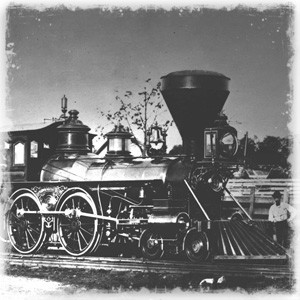
The railroad -- the one many of us call The Monon -- was formed in 1847 when a group of Salem and New Albany businessmen met at what is now Borden. The Salem businessmen were interested in finding a better way to haul goods into Washington County, and to ship items from here to the river.
James Brooks of New Albany, who for several years had dreamed of building a railroad the full length of the state, was elected president of the new railroad.
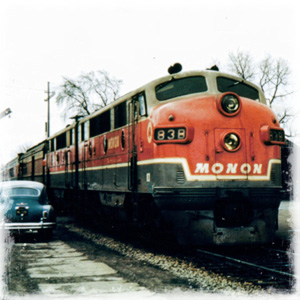
January 14, 1851, the first passenger train rolled into Salem. Thousands flocked along South Main Street to get their first glimpse of this unusual piece of equipment that was to bring prosperity to Washington County.
By the time that first train reached Salem, James Brooks' plan to push on to Lake Michigan was already well in motion. The right-of-way was acquired along much of the line using, in some places, the right-of-way of a proposed, but failed, road that was to reach from New Albany to Crawfordsville.

On June 24, 1854, the last spike in the 288-mile line was driven seven miles north of Greencastle. The railroad had been constructed at a cost of $6 million. July 3, 1854, the first through-train left Michigan City at 5 a.m. and averaging 16 miles per hour headed south. It reached New Albany at 10p.m.
For four years trains along the line would carry the name "New Albany and Salem Railroad." Then financial disaster struck the railroad and following reorganization in 1858, it emerged as the Louisville, New Albany, and Chicago Railroad, a name that more appropriately described the cities it served.
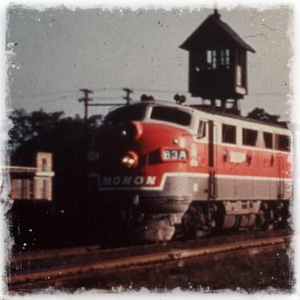
Monon Daily train (Train 14 and 15) operating Chicago-Indianapolis. Usual consist was baggage, mail/express, reclining seat coaches, observation, lounge-parlor car, dining-bar car. This train was discontinued in 1959.

Monon Daily train (Train 11 and 12) operating Chicago-Indianapolis. Usual consist was baggage, mail/express, reclining seat coaches, dining/parlor car. This train was discontinued in 1959.

Sometimes known as The Night Express, Train 3-4. This overnight train operated Chicago to Louisville and carried Pullman cars bound for the hotels at French Lick and West Baden, Indiana. The usual consist included a baggage, express, coaches and Pullman coaches. This train disappeared after 1949.
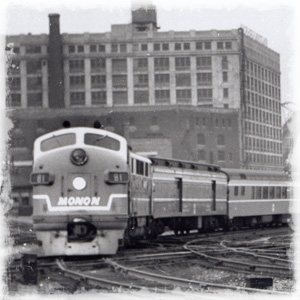
Monon Train 5-6. Operating Chicago to Louisville, this was the longest lived of the Monon's passenger trains, lasting until September, 1967. Usual consist was baggage, RPO, coach, cafe-lounge, parlor car. Monon management retired this train in style, behind new high hood steam generator equipped Alco C- 420's.

In 1847 James Brooks met with six associates and organized the New Albany and Salem Railroad. Brooks was the first President of the New Albany and Salem Railroad, later the Monon Railroad. The railroad was conceived originally to link New Albany on the Ohio River and Lake Michigan at Michigan City, Indiana. At the founding of the railroad, Michigan City was considered the the better location on Lake Michigan.
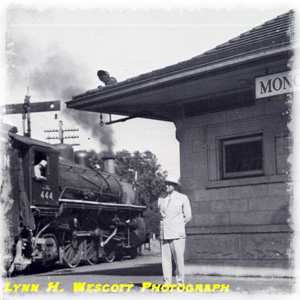
Barriger became President of the Monon in 1946 and is credited with changes to the Monon Railroad. Barriger advocated Super Railroading and did his best to bring this concept to the Monon. Barriger dieselized the railroad and supervised the conversion of surplus U.S. Army hospital cars into a fleet of streamlined passenger cars. Barriger also engineered a public relations campaign to celebrate the railroad's 100th birthday in 1947. He resigned in 1952.
This is a premium level of membership in the Monon Railroad Historical-Technical Society, Inc. This lifetime membership may also be purchased by individuals. This lifetime membership includes 3 issues of The Hoosier Line (view here) and calendar every year for the rest of your life.
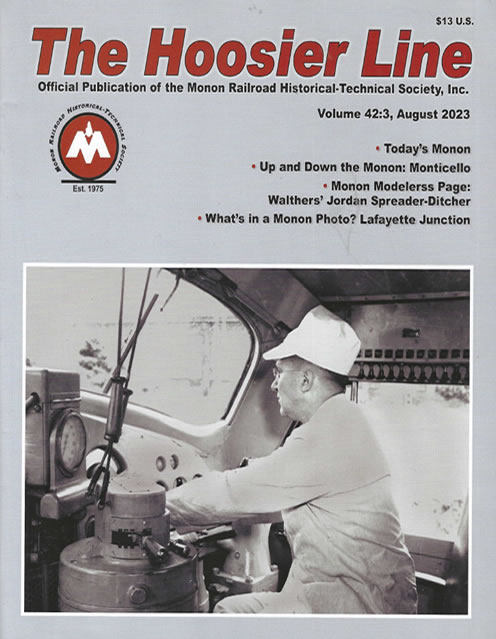
The Hoosier Line Magazine Example Click to download THL |
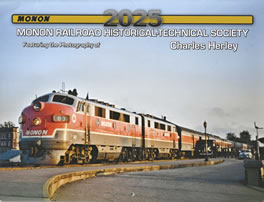
Yearly MONON Calendar A different picture every month. Click to view Calendar |
Membership Information
Download Membership Application ONLINE Membership Application The Monon Railroad Historical Society, Inc. operates on a calendar year basis, from January 1 to December 31. To become a member of the Monon Railroad Historical-Technical Society, Inc.print the application and return it, with check or money order, to our Membership Chairman. Please be patient. We are still a volunteer organization, but we will make every attempt to process your membership or renewal as fast as possible. Yearly all membership levels include: Monon Railroad Historical-Technical Society Membership Yearly Calendar 3 The Hoosier Line magazines 1 News and Timetables magazine For more information email: membership@monon.org |
Monon Railroad Historical-Technical Society, Inc.
Membership Information and Policies
The Monon Railroad Historical-Technical Society, Inc. (Monon Society) offers, yearly, and lifetime classes of memberships. All membership classes except Regular help provide support and funding for: 1) the purchase and upkeep of archival materials, 2) the restoration and maintenance of currently owned railroad equipment, 3) and the upkeep and expenses of the Monon Society headquarters at Salem, Indiana in The Depot Museum. The Regular Membership classes only cover the actual costs of the publishing and mailing of The Hoosier Line magazine and calendar. Your membership is the most important asset of the Monon Society. Your support and activities within the organization are appreciated.
The Monon Society operates on a calendar year basis (Jan. 1st to Dec. 31st). The due date for all yearly membership renewals for the following year is December 31st each year. All membership classes receive the same publications during the year.
Membership payments need to be made only once per calendar year. If you should make more than one payment in a calendar year, the excess amount will be applied to your membership for the following year. Membership Application Forms are sent with most publication mailing as a reminder to you to renew, or for you to pass on to someone else who might be interested in joining the Monon Society.
You may renew your membership or start a new membership by filling out the Membership Application Form on the reverse side and sending a check to the address listed, or by visiting the Monon Society’s website at www.monon.org, selecting "Become a Member” and choosing the membership class of your choice.
The top line of the mailing label on The Hoosier Line magazine envelope indicates the status of your membership. The first number listed on the top line is your membership number, which was assigned to you when you originally joined the Monon Society. The second number listed is the last year your current Monon Society membership is valid. If the second number is not the current year or later, your membership has expired. In that case, please consider renewing your membership. The third entry listed on the top line indicates your current membership class.
Membership Policies and The Hoosier Line Magazine
Membership renewals received after the due date for yearly membership may result in a loss of one or more The Hoosier Line issues.
Any issues of The Hoosier Line not shipped due to past due payments or insufficient payments for membership renewals, shall not be provided free of charge.
Any change of address information must be received in a timely fashion to insure delivery to the correct location. Any issues of The Hoosier Line not sent to the incorrect location shall not be provided free of charge.
You may renew your membership or start a new membership by filling out the Membership
Application Form and sending
a check to the address listed on the form.
You may also renew or start a new membership ONLINE at: MRH-TS Online Store.


Return To Home | Contact Us | About Us @2004-2024 Monon Railroad Historical-Technical Society, Inc. All rights reserved.